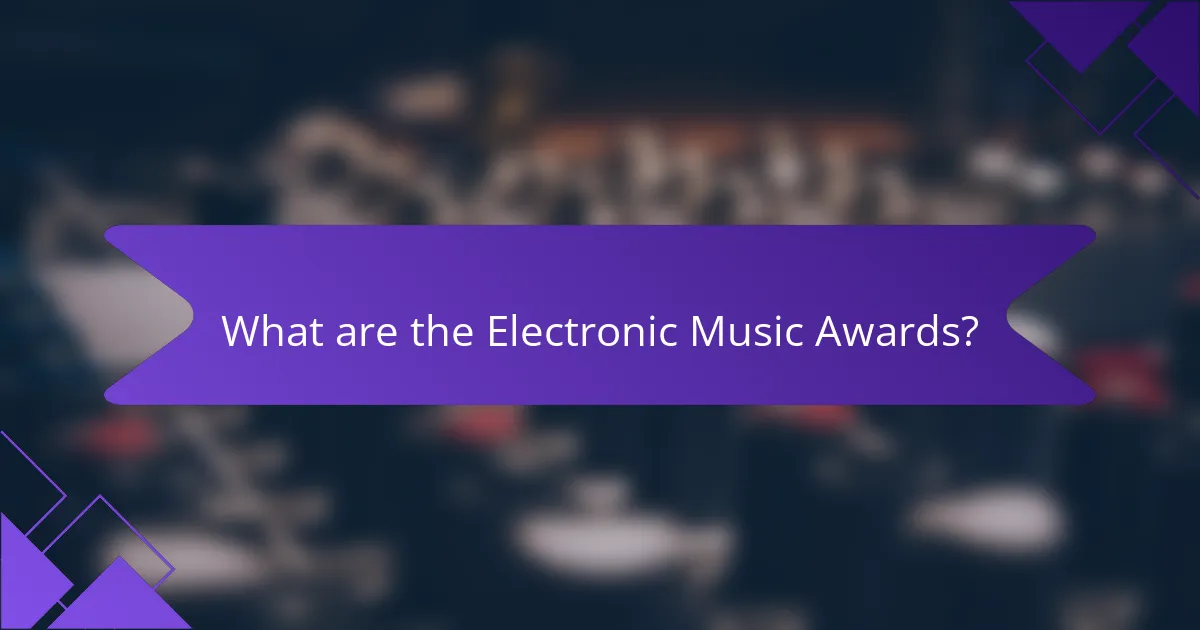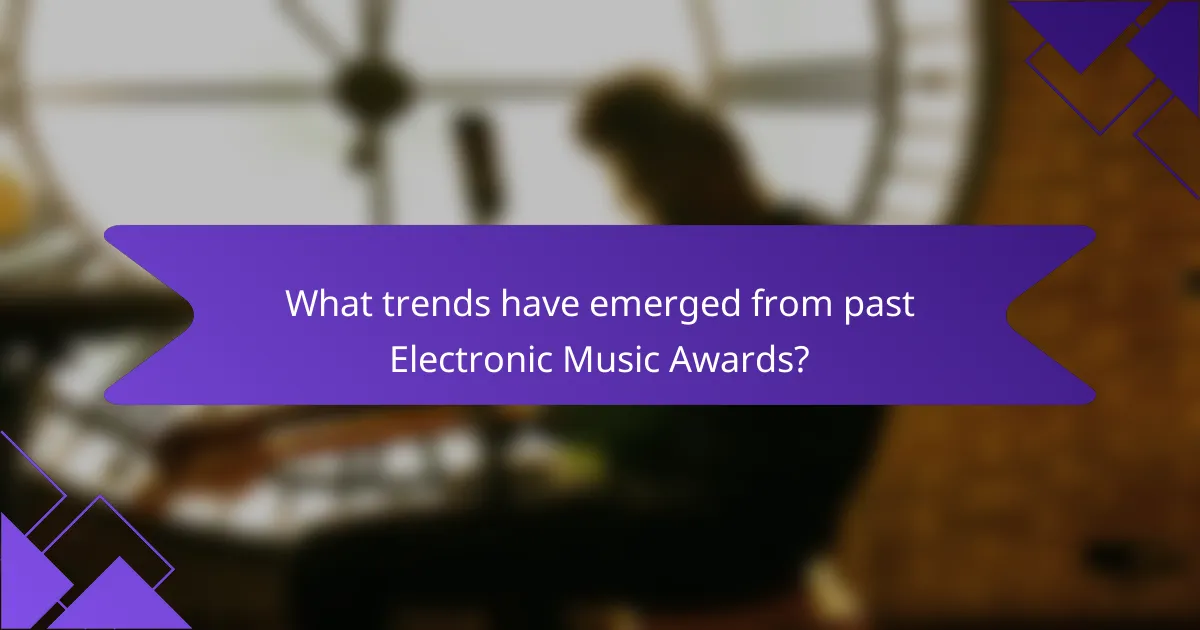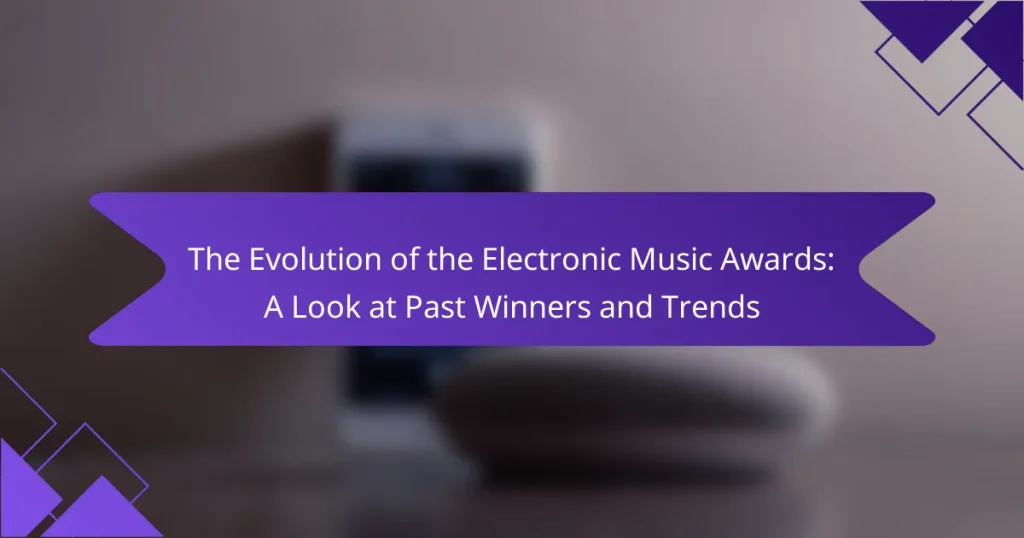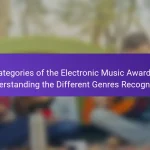The Electronic Music Awards are an annual event recognizing achievements in the electronic music genre, honoring artists, producers, and contributors across various categories since their inception in 2017. The awards celebrate both established and emerging talent, featuring categories such as Best Electronic Album, Best DJ, and Best Live Act, with fan voting complementing industry expert panels. Key trends observed in past ceremonies include the growing recognition of diverse electronic music genres, increased visibility of female artists, and innovative collaborations. The future of the awards looks promising, supported by the global popularity of electronic music, enhanced visibility through major festivals, and advancements in technology that may lead to new award categories.

What are the Electronic Music Awards?
The Electronic Music Awards are an annual event that honors achievements in the electronic music genre. They recognize artists, producers, and other contributors in various categories. The awards celebrate both established and emerging talent. The inaugural ceremony took place in 2017. It aimed to bring visibility to electronic music within the broader music industry. Categories include Best Electronic Album, Best DJ, and Best Live Act. The awards also feature fan voting alongside industry expert panels. The event has evolved to include performances and showcases from nominated artists.
How did the Electronic Music Awards originate?
The Electronic Music Awards originated in 2016. They were created to celebrate and recognize achievements in electronic music. The inaugural event took place in Los Angeles. It aimed to honor artists, producers, and industry professionals. The awards were established by Paul Oakenfold and other industry veterans. Their goal was to create an inclusive platform for electronic music. The event featured live performances and award presentations. It quickly gained recognition within the music community.
What were the initial goals of the Electronic Music Awards?
The initial goals of the Electronic Music Awards were to recognize and celebrate achievements in electronic music. They aimed to provide a platform for artists within the genre. The awards sought to increase visibility for electronic music in mainstream culture. Additionally, they intended to foster a sense of community among electronic music fans and professionals. The event aimed to highlight innovation and creativity within the electronic music scene. These goals were set to elevate the status of electronic music as a legitimate art form.
Who were the first winners of the Electronic Music Awards?
The first winners of the Electronic Music Awards were The Chainsmokers. They received the award for Best New Artist in 2017. This event marked a significant recognition in the electronic music industry. The awards celebrated various artists and contributions to the genre. The Chainsmokers’ win highlighted their impact on electronic music at that time. Their success contributed to the growing popularity of electronic music in mainstream culture.
What is the significance of the Electronic Music Awards in the industry?
The Electronic Music Awards hold significant importance in the music industry. They recognize and celebrate achievements in electronic music. This event highlights the contributions of artists, producers, and innovators in the genre. The awards foster community within the electronic music scene. They also provide visibility to emerging talent and trends. Established in 2017, the awards aim to elevate the status of electronic music. They serve as a platform for industry professionals to connect and collaborate. The Electronic Music Awards influence the direction of future electronic music developments.
How do the Electronic Music Awards influence electronic music trends?
The Electronic Music Awards significantly influence electronic music trends by recognizing and promoting emerging artists and genres. This annual event showcases innovative sounds and styles within the electronic music community. By awarding artists, the event highlights new trends, encouraging mainstream adoption. Past winners often set benchmarks for quality and creativity in the genre. The awards also generate media attention, which amplifies the visibility of nominated artists. This increased exposure can lead to higher streaming numbers and festival bookings. Additionally, the awards create a platform for collaboration among artists, further driving trend evolution. Overall, the Electronic Music Awards serve as a catalyst for change and growth in the electronic music landscape.
Why are the Electronic Music Awards important for artists?
The Electronic Music Awards are important for artists because they recognize and celebrate achievements in the electronic music genre. These awards provide visibility and credibility to artists within a competitive industry. Winning or being nominated can enhance an artist’s reputation and attract new fans. The Electronic Music Awards also offer networking opportunities with industry professionals. This exposure can lead to collaborations, bookings, and increased sales. Additionally, the awards highlight trends and innovations in electronic music. They encourage artists to push creative boundaries and engage with their audience. Overall, the Electronic Music Awards play a significant role in shaping the careers of electronic music artists.

What trends have emerged from past Electronic Music Awards?
Past Electronic Music Awards have shown several key trends. One prominent trend is the increasing recognition of diverse genres within electronic music. Genres such as house, techno, and dubstep have consistently received nominations and awards. Another trend is the rise of female artists in the electronic music scene. Female DJs and producers have gained visibility and accolades, reflecting a shift towards inclusivity. Collaborations between artists from different genres have also become more common. These collaborations often result in innovative sounds that appeal to broader audiences. Additionally, the use of technology in performances has been highlighted. Visual elements and interactive experiences have become integral to live shows. Overall, these trends indicate a dynamic evolution in the electronic music landscape.
How have the genres represented at the awards changed over time?
The genres represented at the Electronic Music Awards have evolved significantly over time. Initially, the awards primarily focused on house and techno genres. As electronic music grew, genres like dubstep, trance, and drum and bass gained prominence. In recent years, genres such as future bass and EDM have emerged as major contenders. This shift reflects broader trends in listener preferences and technological advancements in music production. For example, the rise of streaming platforms has influenced genre popularity. Additionally, collaborations across genres have blurred traditional boundaries, leading to more diverse nominations. The awards now celebrate a wider array of styles, showcasing the dynamic nature of electronic music.
What are the most awarded genres in the history of the Electronic Music Awards?
The most awarded genres in the history of the Electronic Music Awards are house, techno, and trance. House music has received numerous accolades for its influence and popularity. Techno is recognized for its innovation and strong following. Trance has also garnered multiple awards due to its emotional depth and dedicated fanbase. These genres have consistently dominated the awards, reflecting their significant impact on the electronic music landscape.
How have emerging genres influenced the awards?
Emerging genres have significantly influenced awards by broadening the scope of recognized musical styles. This evolution has led to the inclusion of categories for genres like EDM, trap, and lo-fi. As a result, these genres have gained visibility and legitimacy within prestigious award shows. For instance, the introduction of electronic music categories at the Grammy Awards reflects this shift. Additionally, emerging genres often attract new audiences, which can impact voting and nominations. The rise of streaming platforms has also facilitated the discovery of these genres, further influencing award trends. Overall, the recognition of emerging genres has reshaped the landscape of music awards.
What patterns can be observed in past winners?
Past winners of the Electronic Music Awards show consistent trends in genre dominance. Most winners belong to popular electronic genres like house, techno, and trance. Winners often demonstrate significant social media presence and fan engagement. Many past winners have collaborated with well-known artists, enhancing their visibility. Awards frequently recognize innovative production techniques and unique soundscapes. The voting process often favors artists with previous nominations or industry recognition. Additionally, geographical trends reveal a concentration of winners from major music hubs like Los Angeles and Berlin. These patterns illustrate the evolving landscape of electronic music and its recognition at the awards.
Which artists have won multiple awards, and what does this indicate?
Artists such as Calvin Harris, David Guetta, and Tiësto have won multiple electronic music awards. Winning multiple awards indicates a high level of recognition and influence in the electronic music genre. These artists have consistently produced chart-topping hits and have a significant fan base. Their achievements reflect both artistic merit and commercial success. Awards often signify industry respect and can enhance an artist’s career longevity. For example, Calvin Harris has won numerous awards at the EDM Awards, showcasing his impact on the genre.
How do past winners reflect the evolution of electronic music?
Past winners of electronic music awards illustrate the genre’s progression over time. They showcase shifting musical styles, technological advancements, and cultural influences. For instance, early winners often represented house and techno, reflecting the genre’s origins in the 1980s. As the years progressed, winners began incorporating elements from pop, hip-hop, and experimental music. This indicates a blending of genres and the influence of mainstream culture on electronic music.
Moreover, award categories have evolved to include sub-genres such as dubstep, trance, and future bass. This diversification highlights the growing complexity and variety within the electronic music landscape. Notable winners like Daft Punk and Calvin Harris have pushed boundaries, setting new standards for production and performance. Their recognition at awards reflects shifts in audience preferences and the industry’s response to emerging trends.
Overall, past winners serve as a timeline, marking key developments in electronic music’s history and its ongoing evolution.

What are the future prospects for the Electronic Music Awards?
The future prospects for the Electronic Music Awards appear promising. The increasing popularity of electronic music globally supports this growth. Major festivals and events continue to showcase electronic artists, enhancing visibility. Social media platforms facilitate broader engagement with fans. The rise of streaming services contributes to the genre’s accessibility. Collaborations between electronic artists and mainstream musicians are likely to attract new audiences. Additionally, technological advancements in music production may lead to innovative award categories. As the electronic music scene evolves, the awards are expected to adapt and grow in relevance.
How might the Electronic Music Awards adapt to changing musical landscapes?
The Electronic Music Awards might adapt to changing musical landscapes by incorporating diverse genres and emerging artists. They can expand categories to reflect new trends in electronic music. This includes recognizing sub-genres like future bass or lo-fi. The awards can also engage audiences through online voting platforms. By utilizing social media, they can connect with a broader audience. Collaborations with popular streaming services can enhance visibility. Additionally, they may host virtual events to reach global audiences. Adapting to technological advancements will ensure relevance in the evolving music scene.
What role will technology play in the future of the Electronic Music Awards?
Technology will play a crucial role in the future of the Electronic Music Awards. It will enhance audience engagement through interactive voting systems. Virtual reality will allow fans to experience the awards in immersive environments. Streaming technology will enable global access to the event, increasing viewership. Data analytics will provide insights into audience preferences and trends. Blockchain technology may be used for transparent voting processes. AI can help in curating nominations based on emerging music trends. These advancements will modernize the awards and make them more inclusive.
What can artists learn from the history of the Electronic Music Awards?
Artists can learn about the evolution of electronic music and industry recognition from the history of the Electronic Music Awards. The awards highlight trends in music styles and technology over the years. Analyzing past winners reveals the shifting preferences of audiences and critics. Artists can identify successful genres and innovative approaches celebrated in the awards. The history shows how collaboration and community impact the electronic music scene. Learning from previous nominees and winners can inspire new creative directions. The awards also reflect the importance of adapting to industry changes and audience expectations. Overall, the Electronic Music Awards serve as a valuable case study for artists aiming to succeed in the electronic music landscape.
How can emerging artists leverage the awards for their careers?
Emerging artists can leverage awards to enhance their careers by gaining recognition and credibility. Winning an award can significantly increase their visibility in the competitive music industry. Awards can attract media attention, leading to interviews and features in music publications. This exposure can help artists grow their fan base and connect with industry professionals. Additionally, awards can open opportunities for performance slots at festivals and events. Many award-winning artists report increased booking requests and collaborations post-win. Statistics show that artists with awards often experience a boost in streaming numbers and sales. Overall, leveraging awards can lead to sustained growth and success in an artist’s career.
What strategies can artists employ to increase their chances of winning?
Artists can increase their chances of winning by focusing on networking, quality of work, and audience engagement. Building relationships within the industry can lead to more opportunities and visibility. High-quality music production is essential for standing out among competitors. Engaging with fans through social media can create a loyal following. Participation in live events can enhance exposure and credibility. Collaborating with other artists can broaden reach and introduce new audiences. Staying updated on industry trends can inform strategic decisions. Consistent branding helps create a recognizable identity. These strategies align with successful artists’ practices in previous Electronic Music Awards.
The Electronic Music Awards are an annual event that celebrates achievements in the electronic music genre, recognizing both established and emerging artists across various categories. Originating in 2016 and first held in 2017, the awards aim to increase visibility for electronic music within the broader music industry and foster community among fans and professionals. Key topics covered include the significance of the awards, trends in past winners, the evolution of recognized genres, and strategies for emerging artists to leverage these awards for career advancement. The article also explores the future prospects of the awards in response to changing musical landscapes and technological advancements.


